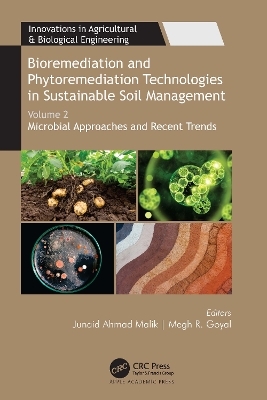
Bioremediation and Phytoremediation Technologies in Sustainable Soil Management
Apple Academic Press Inc. (Verlag)
978-1-77463-892-7 (ISBN)
This 4-volume set focuses on the use of microbial bioremediation and phytoremediation to clean up pollutants in soil, such as pesticides, petroleum hydrocarbons, metals, and chlorinated solvents, which reduce the soil's fertility and renders it unfit for plant growth.
Volume 2: Microbial Approaches and Recent Trends focuses on new and emerging techniques and approaches to address soil pollution. These include the use of rhizobacteria, archaea, cyanobacteria, and microalgae as biofertilizers and for soil bioremediation efforts. New technologies for assessment of soil bioremediation are explored also. The chapters provide in-depth coverage of the mechanisms, advantages, and disadvantages of the technologies used and highlight the use of different microbial enzymes that are used in the process of bioremediation and phytoremediation to clean up different pollutants without causing damage to the natural environment.
Other volumes in the 4-volume set:
• Volume 1: Fundamental Aspects and Contaminated Sites
• Volume 3: Inventive Techniques, Research Methods, and Case Studies
• Volume 4: Degradation of Pesticides and Polychlorinated Biphenyls
Together, these four volumes provide in-depth coverage of the mechanisms, advantages, and disadvantages of the bioremediation and phytoremediation technologies for safe and sustainable soil management. The diverse topics help to arm biologists, agricultural engineers, environmental and soil scientists and chemists with the information and tools they need to address soil toxins that are a dangerous risk to plants, wildlife, humans and, of course, the soil itself.
Junaid Ahmad Malik, PhD, is a Lecturer with the Department of Zoology at Government Degree College, Bijbehara, Kashmir (J&K), India. He has published research articles and technical papers in international journals and has authored and edited books, book chapters, and popular editorial articles. He also serves as an editor and reviewer for several journals. Megh R. Goyal, PhD, PE, is a prolific author and editor. He is a retired professor from the College of Engineering at the University of Puerto Rico. A former soil conservation inspector, Dr. Goyal was proclaimed as the “Father of Irrigation Engineering in Puerto Rico for the twentieth century” by the ASABE, Puerto Rico Section, for his pioneering work on micro irrigation, evapotranspiration, agroclimatology, and soil and water engineering.
PART 1: RHIZOREMEDIATION AND ARCHAEA 1. Role of Rhizobacteria in Phytoremediation of Metal Contaminated Lands 2. Role of Archaea in the Remediation of Contaminated Soils PART 2: ROLE OF MICROALGAE AND FUNGI IN BIOREMEDIATION 3. Microalgae and Cyanobacteria: Potential Biofertilizers 4. Microalgae as Biofertilizer for Sustainable Agricultural Productivity 5. Microbial Biotechnology: Potential of Fungal Enzymes in Soil Bioremediation 6. Soil Bioremediation Strategies Based on Fungal Enzymes PART 3: RECENT TRENDS AND APPROACHES IN BIOREMEDIATION 7. Assessment of Current Soil Bioremediation Technologies 8. Sustainable Agroecosystems: Recent Trends and Approaches in Phytoremediation and Rhizoremediation 9. Sustainable Soil Health and Crop Improvement: Recent Trends in Bioremediation Tools 10. Assessment of Remediation Efficiency: Microbial Indicators of Soil Health 11. Recent Trends in Transgenic Plants for Enhanced Phytoremediation 12. Nanobioremediation: An Integrated Approach for Management of Contaminated Sites
| Erscheinungsdatum | 03.05.2022 |
|---|---|
| Reihe/Serie | Innovations in Agricultural & Biological Engineering |
| Zusatzinfo | 11 Tables, black and white; 7 Line drawings, color; 1 Line drawings, black and white; 2 Halftones, color; 3 Halftones, black and white; 9 Illustrations, color; 4 Illustrations, black and white |
| Verlagsort | Oakville |
| Sprache | englisch |
| Maße | 156 x 234 mm |
| Gewicht | 612 g |
| Themenwelt | Naturwissenschaften ► Geowissenschaften ► Geologie |
| Weitere Fachgebiete ► Land- / Forstwirtschaft / Fischerei | |
| ISBN-10 | 1-77463-892-4 / 1774638924 |
| ISBN-13 | 978-1-77463-892-7 / 9781774638927 |
| Zustand | Neuware |
| Haben Sie eine Frage zum Produkt? |
aus dem Bereich


